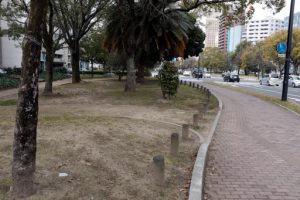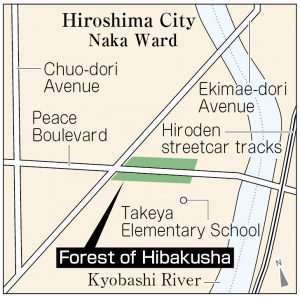At request of A-bomb survivors groups, Hiroshima City to regreen the Forest of Hibakusha, made up of trees from 47 prefectures in Japan, within fiscal year
Feb. 22, 2021
by Shuhei Inomata, Staff Writer
Several representative and other tree species from Kochi, Ishikawa, and Hokkaido Prefectures have died and been removed from the Forest of Hibakusha, located in Hiroshima’s Naka Ward. The forest displays prefectural trees or their substitutes from Japan’s 47 prefectures and was planted to honor the wishes of A-bomb survivors’ groups throughout Japan for the elimination of nuclear weapons. With continued deterioration of the explanatory plates attached to each of the trees in the forest, the A-bomb survivors groups made the request for improvement to the Hiroshima City government, which is responsible for the forest’s maintenance. The city is planning to begin tree replanting and other restoration efforts by the end of this fiscal year.
The dead arboreal varieties include asunaro (a type of arborvitae) from Ishikawa Prefecture, shirakashi (an oak variety) from Kochi Prefecture, and lilacs from Hokkaido, all of which were planted in 1990. According to the city’s Greenery Policy Division and Naka Ward’s maintenance division, none of the trees showed signs of problems in a March 2016 survey on trees in the forest.
With consideration of the climate in the relatively dry Setouchi region, in which Hiroshima is located, trees from cold regions in Japan planted in the forest were not the prefectural representatives, which can survive only in cold weather conditions. Regardless, the trees were assumed to have died because of climate changes driven by recent global warming and/or disease.
Records show that a shirakashi tree was cut down in March 2017. When a survey on trees was conducted in March 2019, it found that asunaro and lilac trees had also died, leading to their removal. In addition, the survey found that five of the explanatory plates describing the tree name and originating prefecture had been lost, and that descriptions written on eight of the plates had faded with age.
The Forest of Hibakusha is located on about one-hectare of land in a green belt at the east end of Peace Boulevard in the city’s Naka Ward. The Japan Confederation of A- and H-Bomb Sufferers Organizations led its development in 1990 and later donated the space to the city. The forest has been used as a venue for peace education programs such as community study classes for students at the nearby Takeya Elementary School and volunteer guide tours led by A-bomb survivors.
Upon learning of the deaths of the trees from the three prefectures, the Hiroshima Prefectural Confederation of A-bomb Sufferers Organizations (Hiroshima Prefectural Hidankyo, chaired by Sunao Tsuboi) and the association of A-bomb victims in Hiroshima (chaired by Akio Kanzaki) requested in January that the city government replant the trees and repair the damaged explanatory boards. The city has explained that it would like to begin restoration efforts as soon as possible within the current fiscal year.
Satoshi Tanaka, a director of the Hiroshima Prefectural Hidankyo, said, “I hope the restoration will encourage more people to take an interest in the forest.”
(Originally published on February 22, 2021)
Plan designed to replant dead trees, repair damaged explanatory plates, and reinstall lost explanatory plates
Several representative and other tree species from Kochi, Ishikawa, and Hokkaido Prefectures have died and been removed from the Forest of Hibakusha, located in Hiroshima’s Naka Ward. The forest displays prefectural trees or their substitutes from Japan’s 47 prefectures and was planted to honor the wishes of A-bomb survivors’ groups throughout Japan for the elimination of nuclear weapons. With continued deterioration of the explanatory plates attached to each of the trees in the forest, the A-bomb survivors groups made the request for improvement to the Hiroshima City government, which is responsible for the forest’s maintenance. The city is planning to begin tree replanting and other restoration efforts by the end of this fiscal year.
The dead arboreal varieties include asunaro (a type of arborvitae) from Ishikawa Prefecture, shirakashi (an oak variety) from Kochi Prefecture, and lilacs from Hokkaido, all of which were planted in 1990. According to the city’s Greenery Policy Division and Naka Ward’s maintenance division, none of the trees showed signs of problems in a March 2016 survey on trees in the forest.
With consideration of the climate in the relatively dry Setouchi region, in which Hiroshima is located, trees from cold regions in Japan planted in the forest were not the prefectural representatives, which can survive only in cold weather conditions. Regardless, the trees were assumed to have died because of climate changes driven by recent global warming and/or disease.
Records show that a shirakashi tree was cut down in March 2017. When a survey on trees was conducted in March 2019, it found that asunaro and lilac trees had also died, leading to their removal. In addition, the survey found that five of the explanatory plates describing the tree name and originating prefecture had been lost, and that descriptions written on eight of the plates had faded with age.
The Forest of Hibakusha is located on about one-hectare of land in a green belt at the east end of Peace Boulevard in the city’s Naka Ward. The Japan Confederation of A- and H-Bomb Sufferers Organizations led its development in 1990 and later donated the space to the city. The forest has been used as a venue for peace education programs such as community study classes for students at the nearby Takeya Elementary School and volunteer guide tours led by A-bomb survivors.
Upon learning of the deaths of the trees from the three prefectures, the Hiroshima Prefectural Confederation of A-bomb Sufferers Organizations (Hiroshima Prefectural Hidankyo, chaired by Sunao Tsuboi) and the association of A-bomb victims in Hiroshima (chaired by Akio Kanzaki) requested in January that the city government replant the trees and repair the damaged explanatory boards. The city has explained that it would like to begin restoration efforts as soon as possible within the current fiscal year.
Satoshi Tanaka, a director of the Hiroshima Prefectural Hidankyo, said, “I hope the restoration will encourage more people to take an interest in the forest.”
(Originally published on February 22, 2021)









